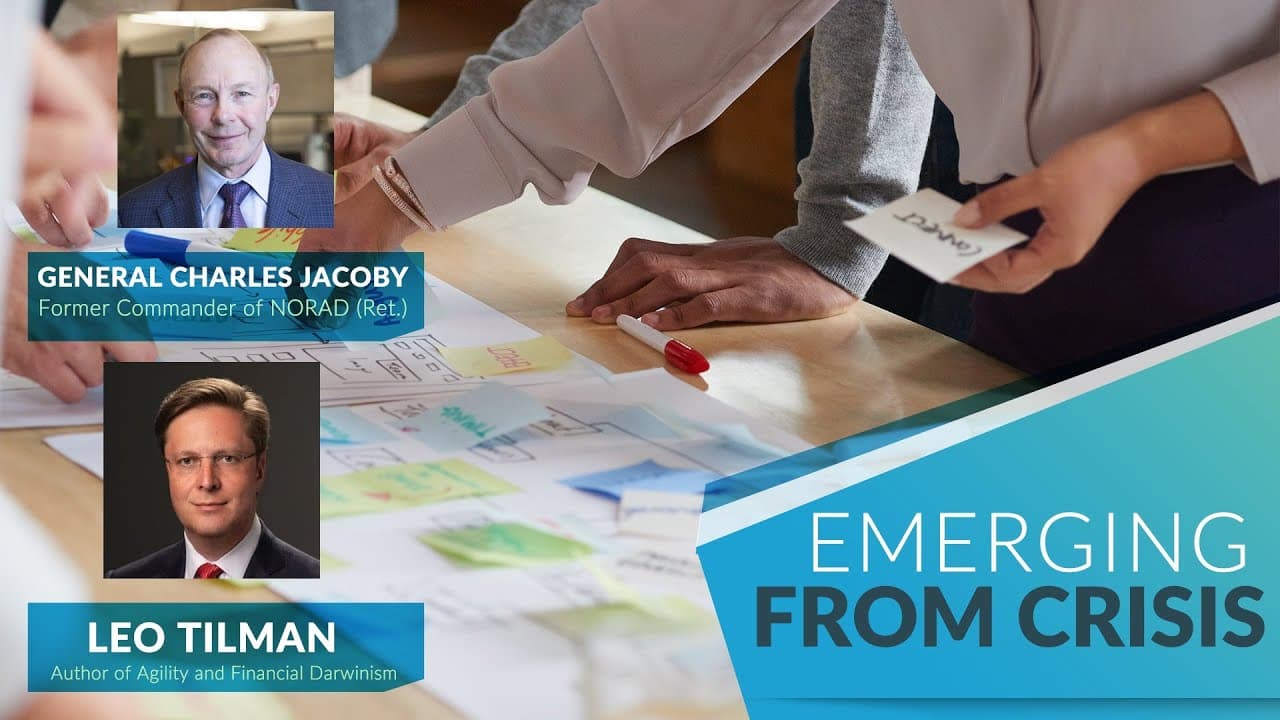Hello everybody, and welcome to this session of the Business Agility Institute's Emerging from the Crisis conference. It’s a pleasure to be here. For General Jacobian and myself, the topic of agility is near and dear to our hearts, as we’ve spent many years thinking about it and describing it in our new book, Agility.
When we began exploring agility, we focused on one of the biggest challenges facing boards and executives across industries: the ability to navigate disruption and uncertainty. While the pandemic amplified this challenge in unprecedented ways, even before then, we saw an environment fraught with volatility and complexity. Organizations were struggling to navigate continuous change.
We saw this accelerating change driven by the Fourth Industrial Revolution, where every industry in every country faced some form of disruption. But beyond technological shifts, this landscape was also shaped by geopolitical conflicts, societal transformations, and economic multipolarity. As we studied the forces shaping businesses, we realized the urgent need to clarify what agility truly means and how organizations can achieve it.
Defining Agility
As we delved deeper into organizational agility, we encountered a significant challenge: intellectual confusion. Outside the world of Agile software development, where agility has a well-defined meaning, executives and boards struggled to define agility in a business context.
We found little consensus on fundamental questions: What does agility really mean? How does it differ from adaptability, resilience, or speed? Is agility an inborn quality, or can it be deliberately cultivated? We firmly believe in the latter—agility is something organizations can develop and master.
To address this confusion, we sought to formally define agility, deconstruct its components, and create a structured approach that any organization could use to assess and improve its agility.
We define agility as: "The organizational capacity to effectively detect, assess, and respond to environmental changes in ways that are purposeful, decisive, and grounded in the will to win."
From this definition, it’s clear that agility applies to both immediate crises, such as the one we are experiencing now, as well as slower-moving shifts—whether technological, regulatory, or geopolitical.
The Two Types of Agility
Through our research, we identified two distinct but complementary types of agility that organizations must possess:
1. Strategic Agility
Strategic agility is the ability of boards and executive teams to detect, assess, and respond to major changes in the environment. This includes adjusting business models, organizational structures, talent strategies, and balance sheets to remain competitive in a changing world.
2. Tactical Agility
Tactical agility is the ability of employees throughout an organization to overcome challenges, seize opportunities, and take smart risks. For tactical agility to thrive, employees must clearly understand the company's purpose and strategy, enabling them to act with autonomy and confidence.
Many Agile transformations—originating from software development and later expanding into project management—focus primarily on tactical agility. While this is valuable, we advocate for a broader view in which both strategic and tactical agility work in harmony. In our framework, agility must permeate the entire organization, empowering employees at every level to assess and respond to change.
The Three Pillars of Agility
The process of agility—detecting, assessing, and responding to environmental shifts—rests on three fundamental capabilities:
1. Risk Intelligence
Risk intelligence is a forward-looking, strategic discipline that goes beyond traditional risk management. Historically, risk management has been reactive, focused on compliance and loss prevention. In contrast, risk intelligence is about proactively understanding uncertainty and using that knowledge to drive strategic decisions.
This concept aligns with military intelligence, where staying ahead of the environment is key to operational success. Just as a professional football team studies its opponents before a game, businesses must dedicate resources to constantly gathering intelligence on emerging risks and opportunities.
2. Decisiveness
Agile organizations must have leaders who can make timely, informed decisions—even in the face of incomplete information. Decisiveness enables organizations to act with confidence, adjusting course as new information emerges.
3. Execution Dexterity
The ability to execute strategy effectively—while remaining flexible and responsive—is crucial. Execution dexterity ensures that organizations can turn strategic insights into concrete actions, continuously iterating and improving.
Fighting for Risk Intelligence
One of the most critical components of agility is what we call the fight for risk intelligence. This means actively resourcing intelligence-gathering efforts rather than passively expecting leaders to stay informed.
In the military, there is a saying: "Every soldier on the battlefield is a collector." This means that intelligence is gathered at all levels, not just at the top. Similarly, businesses must establish systems where information flows from the front lines to leadership, ensuring that critical insights inform strategic decisions.
The Agility Process
The agility process is an ongoing, multi-pronged cycle of detection, assessment, and response. It operates at two levels:
1. Tactical Execution
At the tactical level, teams execute strategy while continuously gathering feedback from the environment. They make data-driven adjustments to improve performance, much like Agile teams iterating on software development.
2. Strategic Adaptation
At the strategic level, leadership monitors macro changes—economic shifts, competitive threats, regulatory updates—and adjusts the company’s strategy accordingly. In some cases, shifts are so profound that they require organizations to rethink their entire purpose.
Critically, agility must not be confined to teams alone. True agility involves the entire organization, as the most valuable insights often come from the front lines where employees interact directly with customers and competitors.
The Role of Leadership in Agility
While we deliberately set out to write a book about agility—not just leadership—the reality is that leadership plays a pivotal role in making agility a reality.
To achieve true agility, leaders must:
- Clearly define the organization’s purpose and long-term goals.
- Empower employees with the autonomy to make decisions within strategic boundaries.
- Foster a culture of trust, accountability, and continuous learning.
- Ensure agility is not a one-time initiative but an ongoing, embedded capability.
Agility in Times of Crisis and Transformation
Agility is not just about responding to acute crises like the COVID-19 pandemic—it also applies to slower-moving transformations, such as the rise of digital technologies, shifting consumer behavior, and geopolitical change.
To help leaders conceptualize today’s challenges, we categorize key factors into three areas:
1. Risk
Understanding and preparing for public health risks, economic uncertainty, and financial volatility.
2. Uncertainty
Anticipating changes in societal norms, workforce expectations, and consumer behavior.
3. Strategic Response
Developing the cultural and leadership capabilities to proactively navigate these changes.
Final Thoughts
As the world grows more complex, organizations must shift from merely surviving disruption to actively shaping their future. Agility is not a one-time exercise—it is an ongoing capability that allows companies to seize opportunities, mitigate risks, and emerge stronger.
Thank you for your time, and we look forward to continuing this important conversation.





